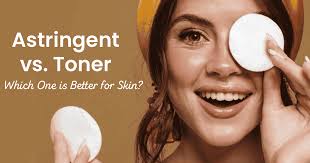
What Is Astringent and How Does It Differ From Toner?
Have you noticed your moisturizer no longer absorbs into your skin as quickly as it used to? Or maybe your skin feels like it’s missing something, but you can’t quite figure out what?
The answer might be astringent, a product that can truly transform your skin. Let’s explore what astringents are, how they work, and how they differ from toners.
What is Astringent?
An astringent is typically a liquid-based formula that often contains rubbing alcohol, also known as isopropyl alcohol.
It is mainly designed for people with oily skin types to help deeply cleanse the skin, tighten pores, and reduce excess sebum.
Sebum is the oily substance produced by skin glands that can sometimes cause blemishes and acne.
When you use an astringent immediately after cleansing, it clears away remaining impurities, prepping your skin to better absorb moisturizers and other treatments.
The term “astringent” originates from the Latin word adstringere, which means “to bind fast.”
This etymology hints at how quickly this product acts on your skin, producing a tightening sensation almost instantly.
Astringents come in many different formulations, often enhanced with additional ingredients to target various skin concerns.
These include redness, breakouts, and dullness, making astringents versatile and effective for improving overall skin health.
Is Astringent the Same as Toner?
If you’re already familiar with skincare, you might think astringents sound very similar to toners.
While both products are applied after cleansing and before moisturizing, there are distinct differences between the two, especially in their ingredients, purpose, and the skin types they suit best. We’ll discuss these differences in detail later.
Benefits of Using Astringent
Using an astringent provides multiple benefits for your skin. Some of the key advantages include:
Tightening the skin and giving it a firmer feel
Reducing inflammation and calming irritated skin
Decreasing blemish breakouts such as spots and blackheads
Cleansing away irritants and impurities from the skin surface
Shrinking the appearance of enlarged pores
Offering anti-bacterial effects to help fight acne-causing bacteria
Unclogging pores to prevent future breakouts
Removing excess oil or sebum that causes a greasy look
Astringents are especially useful for oily and blemish-prone skin types because of their ability to control oil and reduce shine.
However, this does not mean people with normal or dry skin should automatically avoid them.
The market today offers a wide variety of astringents and toners, some with gentler natural ingredients like witch hazel and lemon, which can suit different skin needs.
How to Use Astringent Properly
Astringents should be used as the step following cleansing and before applying serums or moisturizers.
Many astringents contain chemical exfoliants such as salicylic acid or citric acid, which penetrate deeply into the pores, clearing out bacteria, dirt, and any leftover makeup or skincare residues your cleanser might have missed.
Here’s a simple step-by-step guide to using astringent:
Step 1: Cleanse Your Skin
Choose a cleanser suitable for your skin type and always start with cleansing. This step removes makeup, dirt, oil, and dead skin cells that accumulate on your skin surface.
Without this essential step, other products may not work effectively.
Step 2: Apply Astringent or Toner
Soak a cotton pad with your chosen astringent or toner, then gently sweep it over your face, avoiding the delicate eye and mouth areas. After using the pad, you may notice it appears gray or dirty. This is dead skin cells that the astringent has lifted away, revealing fresher, glowing skin beneath.
Pro Tip: If your cotton pad still shows a lot of makeup or residue, it might be time to reconsider your makeup remover or cleanser.
Milk or lotion-based removers used with a damp flannel tend to be more effective than makeup wipes.
Always remove your makeup before cleansing to prevent clogging your pores, much like how taking a shower with your clothes on would defeat the purpose of cleaning.
Step 3: Apply Serums or Moisturizers
After using astringent, your skin is perfectly prepped to absorb serums and moisturizers quickly and efficiently.
You’ll likely notice these products work faster and give better results because they can penetrate deeply without any barriers.
When used correctly, an astringent should leave your skin feeling very clean, perhaps with a slight tingling sensation.
However, if it stings or makes your skin feel uncomfortably tight, the product may be too harsh for your skin, and switching to a gentler toner could be a better option.
What’s the Difference Between Astringent and Toner?
Although astringents and toners appear similar and are used in similar ways, their effects on the skin and the skin types they benefit are different.
Astringents are usually more drying and targeted toward oily and blemish-prone skin.
Toners are gentler and more suitable for dry or sensitive skin types, as they help balance and hydrate the skin.
This difference largely comes down to the ingredients used in each product.
Common Ingredients Found in Toners
Lactic acid, Glycolic acid,Hyaluronic acid, Salicylic acid, Rose water, Witch hazel
Toners often contain mild chemical exfoliants such as lactic or glycolic acid, which work gently on the skin’s surface, helping to exfoliate dead cells while locking in moisture.
This hydration helps dry skin feel plumper and more radiant.
Common Ingredients Found in Astringents
Alcohol (isopropyl), Witch hazel, Citric acid, Salicylic acid
Astringents frequently contain higher levels of alcohol and stronger acids like salicylic acid, a beta hydroxy acid (BHA).
Salicylic acid penetrates deeply to unclog pores and reduce acne but can be harsh on sensitive skin types.
If your skin tends to be oily or greasy with multiple active blemishes, an astringent may be the next step to include in your skincare routine.
Still, it’s advisable to consult a dermatologist before using astringents or toners to make sure you select the best products for your skin.
You can easily find many high-quality astringents and toners at pharmacies and department stores, suitable for various budgets and skin concerns.
Potential Side Effects of Using Astringents
While astringents can be powerful tools for oily skin, they can also cause dryness, irritation, redness, and peeling if used improperly. Therefore, only use astringents if you are confident they suit your skin type.
Oily skin types usually experience the best results without excessive side effects. To minimize irritation, apply the astringent only to the oiliest parts of your face, such as the T-zone, or on blemished areas.
If you have dry skin or suffer from conditions like rosacea or eczema, it’s best to avoid astringents altogether as they may worsen your symptoms.
Regardless of your skin type, always apply a high SPF sunscreen following the use of astringents or toners.
This protects your skin from harmful UV damage, which can be more intense when your skin is exfoliated or treated with acids.
Summary
Astringents and toners serve similar purposes but are tailored to different skin types.
Whether you have oily, dry, or normal skin, including a suitable astringent or toner in your skincare routine can significantly improve the way your skin looks and feels.
By incorporating these products, you help deeply cleanse your skin and remove barriers that might block serums and moisturizers from working effectively.
This allows active ingredients to target fine lines, wrinkles, uneven tone, and more with greater success.
It’s quite remarkable how such a simple bottle of liquid can play such a vital role in skin health and beauty.
Want to Learn More About Chemical Exfoliation?
Are you curious about what chemical exfoliation is and how it can benefit your skin? Check out our detailed guide on how chemical exfoliation works to perfect your complexion and keep your skin glowing.


